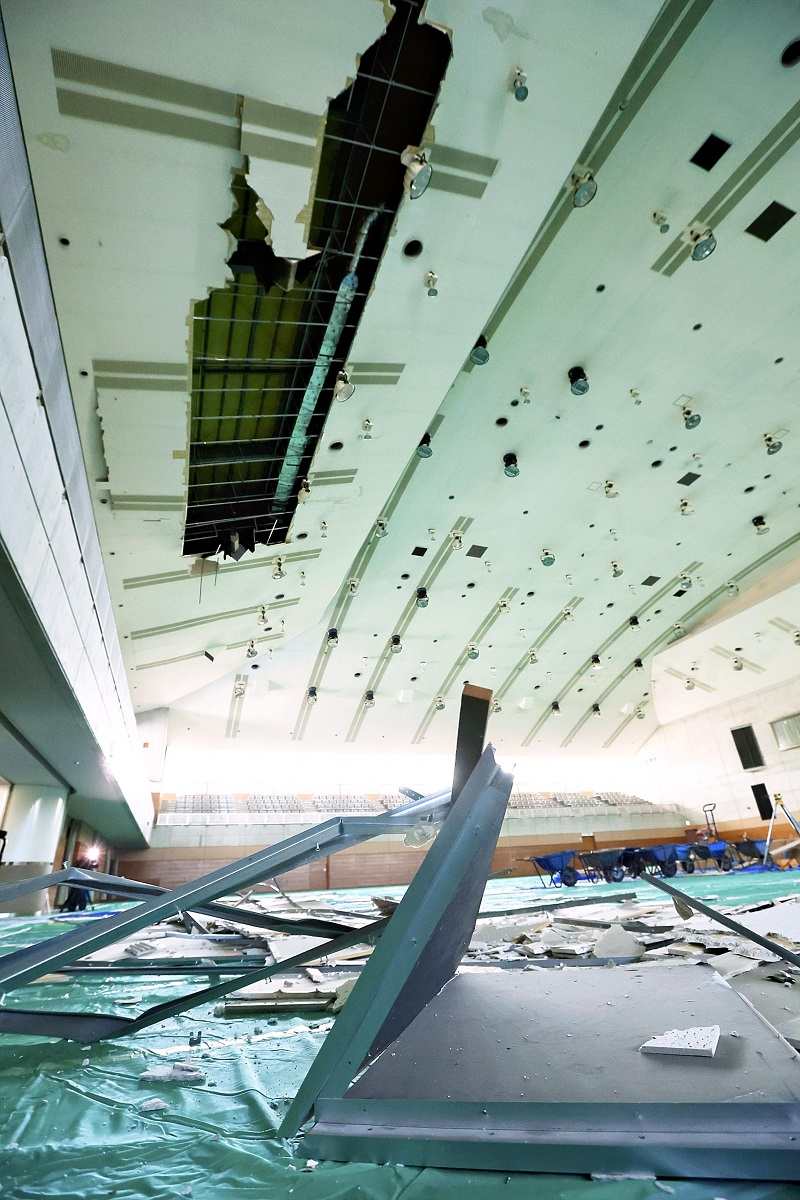Earthquake in Western Japan a Reminder to Be Ready for the Big One; 14% of People Have Made No Preparations, Survey Says

Part of a gymnasium ceiling is seen on the floor after an earthquake in Uwajima, Ehime Prefecture, on Thursday.
20:00 JST, April 19, 2024
The powerful earthquake that struck western Japan late Wednesday has prompted renewed calls for people and local governments to be better prepared for major disasters.
The magnitude-6.6 temblor’s epicenter was at the Bungo Suido channel, between Ehime Prefecture in the Shikoku region and Oita Prefecture in the Kyushu region. This was the first quake in Shikoku to register lower 6 on the Japanese seismic intensity scale of 7 since the current scale was introduced in 1996. Many residents were concerned the shaking might be a sign of a massive earthquake that is expected in the Nankai Trough, but experts believe Wednesday’s quake is unlikely to have any link to the predicted mega-disaster.
Nonetheless, a massive quake could occur in the region at any time. Experts are urging local governments and residents to use the latest quake as an opportunity to ensure they are prepared.
“I suggest people start with preparations that could save their life, such as by securing large pieces of furniture to a wall,” said Tomoya Takani, a disaster management adviser who shares insights and advice on YouTube.
Many people were trapped under fallen furniture in their homes during the 1995 Great Hanshin Earthquake and the 2004 Niigata Prefecture Chuetsu Earthquake. Wednesday’s quake occurred at 11:14 p.m., so many people were likely at home at the time.
The Noto Peninsula Earthquake on Jan. 1 underlined the importance of having food and drink stockpiled for an emergency. Many remote communities were cut off when roads were blocked or damaged by the quake, and relief supplies were slow to get to people in these areas. Experts recommend stocking up on enough supplies to last a week in case of a major catastrophe that causes damage over a large area, such as could occur in a Nankai Trough quake.
But getting everyone to make these preparations has been difficult, as shown by a survey regularly conducted by the Cabinet Office. When asked what they had done to prepare for a major quake, about 24% of respondents to the 2009 survey said, “Nothing in particular.” This dropped to about 11% in the 2013 survey, conducted after the 2011 Great East Japan Earthquake, but then went back up to about 14% in the 2022 survey. Several powerful earthquakes occurred during that time, including the 2016 Kumamoto earthquakes that registered the highest level of 7 on the seismic intensity scale, but these have done little to raise awareness about the need for disaster prepping.
“Some people might be aware of the risk of a disaster, but haven’t been motivated enough to prepare for it,” an official for the Cabinet Office said. “While conducting disaster prevention trainings and events regularly, we must find ways to prod these people to take the first step in getting ready for a disaster.”
Related Tags
"Society" POPULAR ARTICLE
-

M4.9 Earthquake Hits Tokyo, Neighboring Prefectures
-

Israeli Tourists Refused Accommodation at Hotel in Japan’s Nagano Pref., Prompting Protest by Israeli Embassy and Probe by Prefecture
-

M7.5 Earthquake Hits Northern Japan; Tsunami Waves Observed in Hokkaido, Aomori and Iwate Prefectures
-

Tsukiji Market Urges Tourists to Avoid Visiting in Year-End
-

High School in Kyoto Says Students Shoplifted during Recent School Trip to Bali, Indonesia
JN ACCESS RANKING
-

Tokyo Economic Security Forum to Hold Inaugural Meeting Amid Tense Global Environment
-

Keidanren Chairman Yoshinobu Tsutsui Visits Kashiwazaki-Kariwa Nuclear Power Plant; Inspects New Emergency Safety System
-

Imports of Rare Earths from China Facing Delays, May Be Caused by Deterioration of Japan-China Relations
-

University of Tokyo Professor Discusses Japanese Economic Security in Interview Ahead of Forum
-

Japan Pulls out of Vietnam Nuclear Project, Complicating Hanoi’s Power Plans























